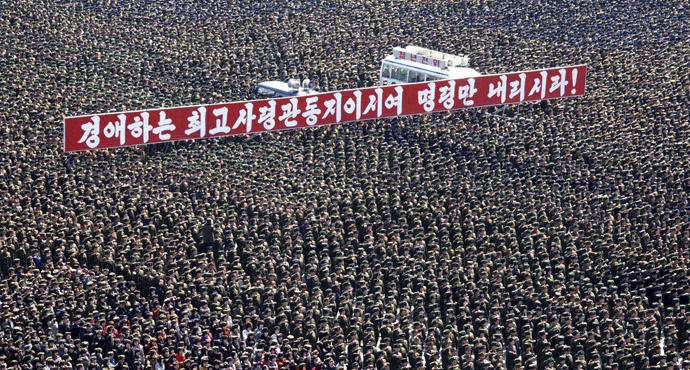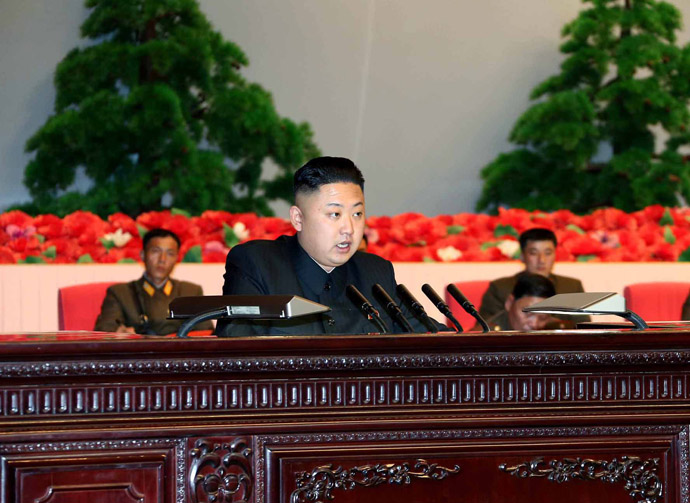North Korea: The stakes behind the rhetoric

The renewed instability on the Korean peninsula showed there is a frightening possibility that the situation could spin out of control – and the complex reasons behind the words and actions of both sides goes beyond a regional conflict.
After the North was heavily penalized by UN sanctions following
its recent satellite launch and nuclear test, Pyongyang has
embarked on a near-daily onslaught of belligerent threats, some of
which include its invalidation of the 1953 armistice agreement that
ended the Korean War, threats to nuke the United States, and
threats to occupy South Korea and subsequently take all Americans
in the country hostage.
Military analysts say that North Korea is at least several years
from building a nuclear warhead or a missile capable of reaching
the US mainland, but there is no doubt that if the Kim regime
oversteps in its approach, there could be severe repercussions for
civilians in South Korea and Japan, both in range of North Korea’s
rockets.
Despite regular threats of destruction and Pyongyang’s recent proclamation that the two Korean states are officially at war, day-to-day life has continued normally according to sources on the ground. Needless to say, there is no doubt that civilians on both sides are feeling the tensions, especially those on disputed South Korean islands in the West Sea, just a stone's throw from the North Korean maritime border.
The 4,000 residents of the South’s Baengnyeong Island, which Kim
Jong-un threatened to “wipe out” in early March, have been
severely hindered from carrying out day-to-day activities such as
fishing due to joint US-ROK military exercises in the area. Despite
inter-Korean relations reaching their lowest point in recent
history, with the entire South on high alert, most South Koreans
are adept at brushing off the North’s rhetoric but are still
exercising caution.

The question remains: What exactly is Kim Jong-un trying to achieve through this campaign of bellicosity? North Korean state media claims that the US “should clearly know that in the era of Marshal Kim Jong-un, the greatest-ever commander, all things are different from what they used to be in the past.” The current approach being taken by Pyongyang is multifaceted, but its central component is building up Kim’s image domestically and rallying the population through nationalism – this has been reinforced by daily public appearances and friendly photo-ops of Kim mingling with local people, as well as an internal propaganda campaign likening him to his grandfather Kim il-Sung, the founder and 'Eternal President' of North Korea.
The central message Pyongyang wants to send both internationally
and domestically is that Kim Jong-un’s era is distinctly different
than his father and grandfather's – many South Korean observers
have also noted this change in approach, aimed at making the
regime’s moves more difficult to predict.
Most analysts are regarding the North’s rhetoric as their
familiar brand of psychological warfare: Cranking up the tensions
and threatening Seoul and Washington with destruction, and then
being rewarded with food aid and concessions when it tones things
down, which it has previously done in the months of April and May –
around harvest time. Pyongyang likely views the present scenario as
an opportune time to test the water, keeping the new
administrations of their neighbors in South Korea, China and Japan
on their toes.
Despite the muscle-flexing and the foolish threats emanating out
of Pyongyang, Washington’s recent deployment of two nuclear-capable
US B-2 stealth bombers illustrates everything that is wrong with US
policy toward the North – this kind of move only serves to raise
antagonisms, and it in fact legitimizes Pyongyang’s rhetoric of the
US threatening nuclear war on the peninsula.

In addition to joint US-ROK’s endless barrage of war games on
North Korea’s doorstep, the brandishing of B-2 bombers, which carry
bombs that can blast through 70 meters of reinforced concrete, is
an unnecessary stunt that is both bold and needlessly provocative.
In fact, the B-2 flyover helps Kim Jong-un in consolidating his
political power at home by rallying domestic support behind the US
threat and distracting North Koreans from economic
problems.
These moves beg the question: Is the United States prepared to
launch a full-scale war against North Korea? Despite the high
public disapproval of overt warfare campaigns launched by the Bush
administration, the unholy status North Korea enjoys in American
mainstream media – coupled with its threats to nuke the United
States and the simple fact that is it a communist state – is likely
enough to coax the average American into supporting a war of
aggression against Pyongyang.
Despite the fact that the war would be relatively easy to sell
to the public, the United States is financially strained and in no
position to engage North Korea and endure massive causalities
within its military, not to mention the risk of pulling China into
the confrontation. Washington would likely find nuclear weapons to
be the most cost-effective way to quell the North Korean threat, an
equally unacceptable scenario.

At this point, North Korea is a godsend for the US
military-industrial complex and defense industry, and South Korea
is set to keep its status as the world’s single biggest importer of
US weaponry. As the Obama administration pursues its 'pivot' to the
Asia-Pacific region, the colorful belligerence of North Korea is
exactly what it needs not only to maintain its unpopular military
presence in South Korea and Japan, but also to further bolster its
military muscle on China’s doorstep.
Despite North Korea’s empty threats, one should not dismiss the
possibility that they will respond to provocations with force, much
like how they shelled South Korea’s Yeonpyeong Island in 2010 as a
response to South Korean military exercises that fired live rounds
into their territorial waters. This kind of small-scale fire
exchange has the possibility to ignite the situation into a larger
and more dangerous standoff, so it is of maximum importance that
cool heads prevail and needlessly provocative displays of military
muscle are scaled back.
Koreans have historically seen themselves as a shrimp amongst
whales – where they saw their peninsula abused by the US and the
Soviet Union yesterday, they fear the same scenario repeating
itself between the US and China today. If the Obama administration
is not careful, it will provoke Pyongyang into doing something
rash. By then, it will already be too late to rectify the
situation.
The statements, views and opinions expressed in this column are solely those of the author and do not necessarily represent those of RT.
The statements, views and opinions expressed in this column are solely those of the author and do not necessarily represent those of RT.













